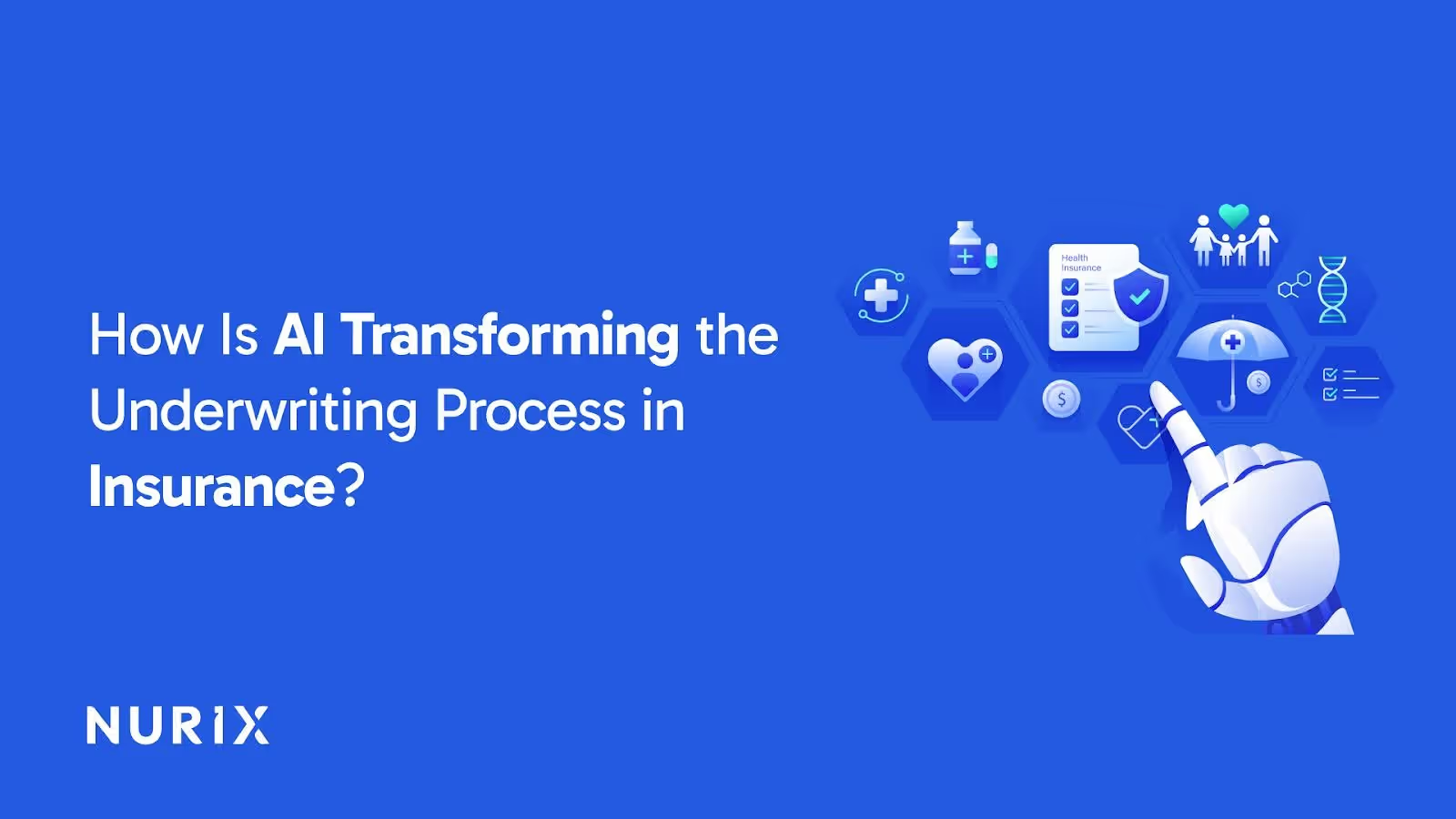How AI is transforming the underwriting process in insurance is a critical question for insurers aiming to boost efficiency and accuracy in risk assessment.
Recent data show that AI has reduced underwriting decision time for standard policies from three to five days to just 12.4 minutes, while improving risk assessment accuracy by over 43% and reducing processing times for complex policies by 31%.
Understanding these advancements is vital for businesses to reduce operational costs, enhance compliance, and improve customer experience.
This blog explores the key AI-driven innovations in underwriting, their impact on insurers' workflows, and actionable insights to leverage AI effectively.
Takeaways
- AI automates complex underwriting workflows, reducing policy approval times from days to minutes while increasing risk assessment accuracy by over 40%.
- Advanced AI technologies like machine learning, NLP, and computer vision enable richer, real-time data analysis from diverse sources, including IoT and unstructured data, driving more precise risk scoring.
- AI-based fraud detection algorithms significantly cut losses by identifying suspicious patterns early, improving underwriting portfolio quality and compliance.
- Integration of AI with human expertise in hybrid workflows preserves ethical judgment and reduces bias, ensuring fairer and more transparent underwriting decisions.
- Early adoption of AI underwriting delivers competitive advantages by accelerating operational efficiency, cutting costs, and enhancing customer experience through personalized, data-driven insurance offerings.
What Is Insurance Underwriting?
Insurance underwriting is the process by which insurers evaluate and decide the level of risk involved in insuring a person, asset, or entity, then set the price and terms for coverage. It’s the foundation for insurer profitability and sustainability.
Some key details of the underwriting process are:
- The applicant provides detailed information and documentation about the risk (for example, financial statements for businesses or property condition reports for homeowners).
- The underwriter reviews all materials, requests additional data if needed, and may consult with brokers or specialists for complex cases.
- Once sufficient information is collected, the underwriter analyzes the risk using both industry expertise and advanced digital tools (including actuarial models and AI).
- The final step is to set a premium, policy terms, and coverage limits, or decline the application if it doesn’t meet the company’s risk appetite.
Curious how AI is rewriting the rules insurers follow for risk and pricing? Let's explore the transformative power of intelligent automation at work.
How is AI Transforming Insurance Underwriting?
AI is radically upgrading insurance underwriting through automation, advanced data analytics, and real-time decision-making. Insurers are now moving beyond static risk models and utilizing vast sources of structured and unstructured data to refine every assessment.
Some of the key transformations after the introduction of AI in insurance underwriting are:
- Smart algorithms scan thousands of data points, from social media to IoT sensors, to build sharper risk profiles, resulting in 54% greater accuracy in underwriting decisions.
- Policy approval times are slashed from days to minutes, with AI-driven platforms enabling issuance in just 12.4 minutes on average.
- Advanced machine learning and NLP automate document review and fraud detection, cutting claims processing times by nearly 70% and lowering annual fraud costs by billions.
Automation Impact on Insurance Underwriting:
As technology drives insurers to rethink their entire approach to risk, the benefits of AI in underwriting are reshaping the industry’s core outcomes.
What are the Benefits of AI in Underwriting?
AI enables rapid, high-precision risk assessments. Leading insurers report that decision times for standard policies have dropped from three to five days to just 12.4 minutes, with up to 99.3% accuracy in risk assessment.
Some of the key benefits of using AI in insurance underwriting are:
- Efficiency Gains: Automated data collection and document analysis streamline risk evaluation, allowing teams to process far more applications in less time.
- Enhanced Accuracy: Machine learning models synthesize thousands of data points and identify patterns humans might miss, driving fairer, data-driven pricing.
- Fraud Reduction: AI technologies detect irregularities and prevent fraudulent claims, cutting annual fraud losses by up to 28% for insurers.
- Improved Customer Experience: Faster policy approvals and personalized offerings drive higher customer satisfaction and retention.
- Bias Mitigation: AI models are programmed to review wider, more diverse data sets, minimizing bias and increasing inclusion for marginalized groups.
Building on how AI benefits underwriting, let’s look at concrete ways underwriters are using AI daily to revolutionize their workflows and outcomes.
Top 5 Ways Underwriters Can Use AI
AI empowers underwriters to optimize efficiency and accuracy, allowing them to focus on critical decision-making while automating routine tasks.
1. Automating Data Extraction and Enrichment
AI seamlessly extracts data from complex, unstructured documents like medical reports, financial statements, and broker submissions. This slashes manual entry errors and streamlines the initial data intake process, saving hours per case and accelerating underwriting cycles.
Example: The insurance company Markel implemented AI-based document extraction and enrichment tools to process underwriting submissions more rapidly and with better accuracy. As a result, Markel reported a 113 % uplift in underwriter productivity and a reduction in their quote turnaround time from 24 hours to as little as 2 hours for some partner submissions.
2. Enhancing Risk Assessment
Machine learning models analyze expansive historical and real-time data sets to identify risk patterns with greater precision. This leads to more accurate policy pricing and risk scoring, reducing underwriting inconsistencies and improving loss ratios.
3. Improving Fraud Detection
AI detects anomalies and suspicious patterns in applications and claims far faster than traditional methods. This allows underwriters to focus on high-risk cases and significantly reduce financial losses from fraud.
4. Optimizing Decision-Making
AI-driven analytics offer real-time insights and predictive recommendations, guiding underwriters to make faster and more consistent decisions. This accelerates policy approvals while maintaining underwriting quality and compliance.
5. Streamlining Workflows
AI automates routine administrative tasks such as triaging applications, routing cases, and tracking case status. Underwriters gain bandwidth to focus on complex cases, enhancing productivity and customer responsiveness.
From realizing AI’s benefits to practical uses, it’s important to understand the hurdles insurers face and how to overcome them to fully capitalize on AI’s underwriting power.
Addressing the Challenges and Solutions of AI in Insurance Underwriting
While AI offers substantial advantages, several critical challenges can impede its success in underwriting. Recognizing these limitations and deploying targeted solutions ensures AI adoption is responsible, effective, and sustainable.
Key challenges of AI underwriting and their solution are:
1. AI Bias and Fairness
AI models trained on historical data may replicate or amplify existing biases, leading to unfair risk assessments or pricing.
Solution: Use diverse, representative datasets and apply fairness constraints during model training. Employ continuous bias monitoring and validation. Implement explainable AI (XAI) to provide transparency so humans can detect and correct biased outcomes.
2. Data Quality and Integration
Inaccurate, incomplete, or fragmented data can lower the performance and reliability of AI models. Legacy systems often complicate data unification.
Solution: Establish strong data governance and cleansing protocols. Use unified data platforms with robust APIs for seamless integration of internal and external data sources, improving consistency and accessibility.
3. Explainability and Transparency
Complex AI “black-box” models create difficulties in understanding and trusting underwriting decisions, which is critical for regulators and auditors.
Solution: Adopt explainable AI tools that articulate how decisions are made. Maintain audit trails for all AI-driven choices to comply with regulatory and oversight requirements.
4. Privacy and Security
Managing large volumes of sensitive customer data poses risks of breaches and non-compliance with regulations such as HIPAA and GLBA.
Solution: Implement encryption, strict access control, and anonymization techniques. Use privacy-preserving AI approaches, such as federated learning, to enable AI training without extensive data sharing.
5. Implementation Costs and Scalability
High upfront costs, skill shortages, and complexity slow AI adoption and scaling across underwriting functions.
Solution: Execute phased AI rollouts with pilot projects to demonstrate value. Select modular, scalable AI solutions that adapt to changing business needs, optimizing ROI while lowering risk.
6. Maintaining Human Oversight
Relying solely on AI risks losing critical human judgment, possibly missing edge cases or ethical nuances.
Solution: Design hybrid AI-human workflows where AI augments but does not replace underwriters. Define clear roles, responsibilities, and review processes to ensure accountability and ethical standards.
With a clear understanding of AI's challenges and solutions in underwriting, it’s time to explore how Nurix AI can help insurers confidently utilize this transformative technology.
Get Started With Nurix AI for Insurance Underwriting
Nurix AI offers a comprehensive, enterprise-grade AI platform designed specifically for insurance underwriting teams seeking secure, scalable automation and advanced risk insights. Its no-code AI agent builder allows underwriting leaders to rapidly design, deploy, and customize AI-powered workflows without extensive technical resources.
Key capabilities include:
- Automated Data Ingestion and Enrichment: Seamlessly extract underwriting-relevant data from diverse document types using Nurix’s NLP and OCR tools, speeding data collection while minimizing manual errors.
- No-Code Agentic AI Platform: Nurix’s drag-and-drop agent builder lets underwriters and ops teams create, deploy, and refine custom AI agents, automating everything, without writing a single line of code
- AI-Powered Risk Assessment: Utilize machine learning models integrated through Nurix to improve risk scoring accuracy with transparent, explainable outputs suitable for compliance.
- Workflow Automation and Orchestration: Nurix enables end-to-end underwriting process automation, from application intake to decision routing, reducing cycle times and boosting productivity.
- Strong Security and Compliance: Built to meet stringent enterprise security standards and insurance regulatory requirements such as HIPAA and GLBA, ensuring data privacy and audit readiness.
- Seamless Integration: Easily connect to legacy underwriting systems and third-party data sources via flexible APIs for a unified operational ecosystem.
Conclusion
The transformative power of AI in insurance underwriting is clear: it accelerates decision-making, enhances risk accuracy, and improves operational efficiency, all while reducing costs and bias.
Nurix AI offers no-code AI agents that automate complex underwriting steps, from ingesting and validating documents to delivering real-time, explainable risk scores and orchestrating application workflows
Our platform seamlessly integrates with existing systems, streamlines compliance and audit trails, and supports data-driven decisions while maintaining the security of sensitive information.
Schedule a demo with Nurix AI to see how its agentic automation can help you increase underwriting accuracy, speed, and operational resilience.










